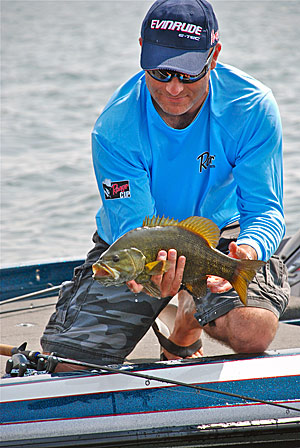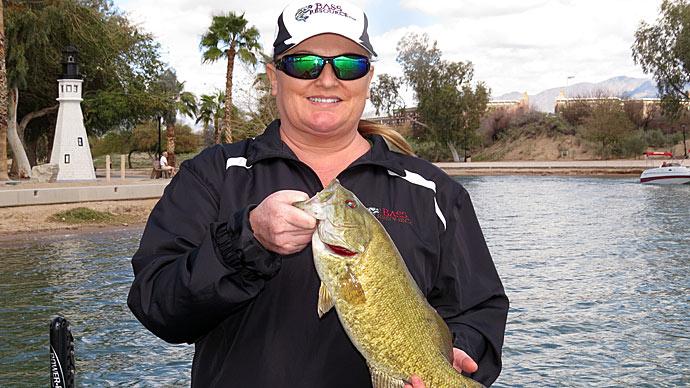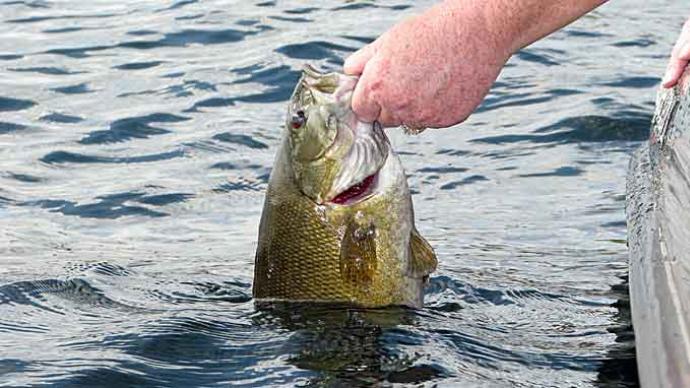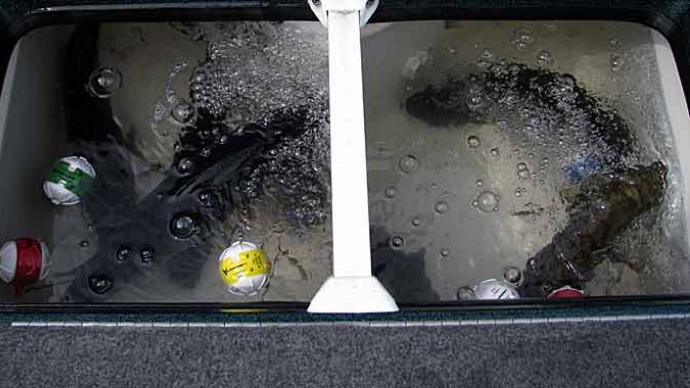
The vast majority of bass fishermen practice catch and release. There are times, though, when you might want to put a bass in the live well to take images when the light is better or you have a better background. Maybe it’s the fish of a lifetime, and you want to keep fishing while the bite is hot and take some shots later. Others may be participating in a tournament, and you need to retain fish for a weigh-in. Keeping bass alive then can be the difference between a big payday and a disappointing finish.
Hot summer weather and temperatures coincide with one of the best times to catch bass. Bass metabolism is in high gear during summer months, and actively feeding bass are the easiest to catch. But summer temperatures make it more challenging to keep bass alive. You need to release bass immediately after catching or take extra precautions to ensure retained fish survive.
“Anytime you can land fish by hand by either lipping them or cradling them is the best, “pro angler Scott Dobson said. He is acutely aware of the importance of keeping bass alive, especially during tournaments. Dobson brought in sacks of bass that were alive and kicking to win major tournaments this year at the FLW Thousand Islands competition and again at a BFL tournament in June on Lake St. Clair. Dobson is a fanatic for keeping the water in his live well oxygenated and cool and has a strict regiment that he typically follows to keep bass alive. But a recent event shows how not paying attention to details can cost you.
“I lost two bass during a recent BFL tournament,” Dobson said. “The fish weren’t hooked deep. I’m usually very cautious about keeping fish alive. I caught the fish early in the day and figured I’d be culling those fish and keeping them in a separate live well. I forgot about them, and they died. I haven’t lost a fish in probably four or five years. I didn’t do very well in the tournament, so the dead bass didn’t cost me any money, but the 4-ounce penalty per fish cost me points, and the 8-ounce total was enough to drop me ten spots.” It was a costly reminder.
Dobson said that recreational anglers who net bass should use a specialized net that reduces stress and harm to bass. Frabill’s line of Conservation Series Nets are designed with safe catch and release in mind. All nets feature 100% knotless mesh netting, eliminating injuries commonly caused by sharp knots. Flat, linear bottoms reduce fish rolling and support the weight of the entire fish. A tangle-free coating prevents hooks from becoming entangled in the net. Conservation Series Nets are offered in various species-specific designs that make proper net selection easy for any angler. The nets recommended for bass come in two sizes- 20” x 23” and 23” x 26”.
The 100% knotless mesh is crucial because it minimizes scrapping the protective slime layer off the bass. The slime layer is a natural barrier against parasites and disease. Knotted nets tend to scrape this layer off as fish thrash and roll in the net. The flat bottom also minimizes contact with the net and supports the fish. The knotless mesh makes it easier to get hooks out quickly and facilitates getting the bass back in the water or the live well without wasting time.
Dobson is a stickler about keeping bass alive and has an ordinarily failsafe routine. “Ice and a thermometer are critical,” he stated. Dobson said he hits the water on hot summer days with five to seven bags of ice to keep bass alive. The locker on his Ranger Z521C will hold up to four 7-pound bags of ice. Dobson hedges his bet by bringing along a Yeti Hooper cooler that holds another three bags of ice.

“On a hot day, I’ll dump a half a bag of ice in the live well every half hour,” advised Dobson. “I’ll pump out the live wells halfway through the day and add fresh water. The aerators are on all day long.” Bass in the live well regurgitate, poop, and expel toxins that deplete oxygen levels.
You need strong batteries to run your electronics and aerators all day. Usually, boats have a bank of batteries to run electrics, aerators, and starting and a jumper system for insurance.
Dobson also uses an add-on device called an Oxygenator to keep bass alive. The OXYGENATOR™ Pro Live Well Flush Mount is a live well oxygenator that will retrofit most boat live wells from 10 to 20 gallons and operates off the existing boat battery.
The Oxygenator™ produces 100% pure oxygen by splitting the hydrogen molecule from the oxygen molecule in the water. This creates a super saturated oxygen environment, even in the warmest water. Independent testing has shown increasing oxygen in live wells improves fish survival by over 35%. There’s no switch required. The Oxygenator automatically activates when the live well fills with water. Experts contend that you need one gallon of water per fish in the live well, but it’s best to err on the side of caution during warm summer conditions.
Some additives can increase oxygen levels in live wells and improve bass survival. Dobson uses a product called G-juice Pro Formula Live Well Treatment but cautioned that G-Juice is only compatible with the Oxygenator system and can be toxic if not used properly. Other products, like Sure-Life™ Please Release Me™, eliminates weight loss, calms fish, replaces slime coat, removes chlorine, and is NOT toxic when used with an Oxygenator.
One of the most critical times for bass and tournament anglers is the weigh-in. “You’ve got about four or five minutes until bass start to expire,” claimed Dobson. “I take the ice with me and put it in with the fish every couple minutes. Smallmouths are harder to keep alive than largemouths because you typically catch them in cooler water. Largemouths are caught in warmer water and don’t get as stressed as smallies. You know they're in trouble when they change color, and their eyes get glossed over.”
A new product by Frabill called the Mesh Weigh Bag with Aerator can take a lot of the stress off of weigh-in and keep bass alive and kicking.’ The product features a padded carry handle and a woven mesh bag that easily slips in and out of weigh bag, making it ideal for tournament anglers. The reinforced weigh bag structure allows the water-filled bag to rest on the ground without support. Other features include a built-in pocket for an auxiliary aerator. The included 14203 aerator runs for 30+ hours on 2 D batteries, helping ensure fish are as healthy as possible leading up to the weigh-in. The Mesh Weigh Bag with Aerator will be available in time for the 2017 tournament season.
Summertime coincides with some of the hottest bass fishing of the year, literally and figuratively. Be sure to take extra steps to ensure the bass you catch live to fight another day.




